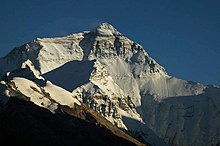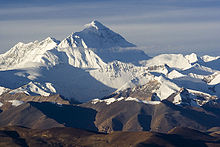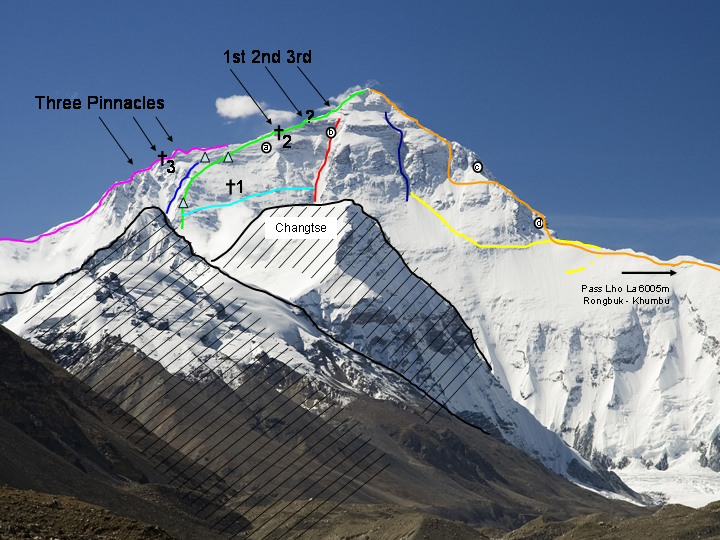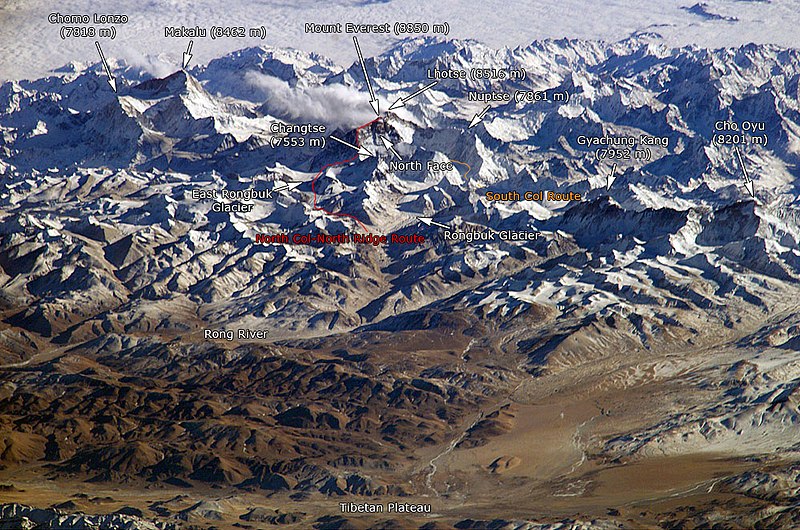
Lhotse is the fourth highest mountain in the world at 8,516 metres (27,940 ft), after Mount Everest, K2, and Kangchenjunga. The main summit is on the border between Tibet Autonomous Region of China and the Khumbu region of Nepal.

Shishapangma, or Shishasbangma or Xixiabangma, is the 14th-highest mountain in the world, at 8,027 metres (26,335 ft) above sea level. It is located entirely within Tibet. In 1964, it became the final eight-thousander to be climbed.
Tim Macartney-Snape is an Australian mountaineer and author. On 3 October 1984 Macartney-Snape and Greg Mortimer were the first Australians to reach the summit of Mount Everest. They reached the summit, climbing without supplementary oxygen, via a new route on the North Face. In 1990, Macartney-Snape became the first person to walk and climb from sea level to the top of Mount Everest. Macartney-Snape is also the co-founder of the Sea to Summit range of outdoor and adventure gear and accessories, a guide for adventure travel company World Expeditions and a founding director and patron of the World Transformation Movement.

The Kangshung Face or East Face is the eastern-facing side of Mount Everest, one of the Tibetan sides of the mountain. It is 3,350 metres (11,000 ft) from its base on the Kangshung Glacier to the summit. It is a broad face, topped on the right by the upper Northeast Ridge, and on the left by the Southeast Ridge and the South Col. Most of the upper part of the face is composed of hanging glaciers, while the lower part consists of steep rock buttresses with couloirs between them. The steep southern third of the Kangshung Face also comprises the Northeastern Face of Lhotse; this section may be considered a separate face altogether following the division of the South "Neverest" Buttress up to the South Col. It is considered a dangerous route of ascent, compared to the standard North Col and South Col routes, and it is the most remote face of the mountain, with a longer approach.
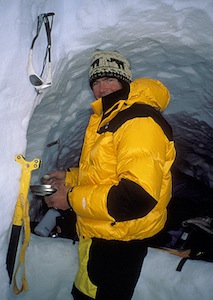
Stewart Alexander Lowe was an American mountaineer. He has been described as inspiring "...a whole generation of climbers and explorers with his uncontainable enthusiasm, legendary training routines, and significant ascents of rock climbs, ice climbs, and mountains all over the world...". He died in an avalanche on Shishapangma, in Tibet. The Alex Lowe Charitable Foundation honors his legacy.
Marco Siffredi was a French snowboarder and mountaineer who hailed from a climbing family; his father was a mountain guide, and his older brother Pierre had died in an avalanche in their hometown of Chamonix, France. Siffredi was the first to descend Mount Everest on a snowboard, completing this feat in 2001 via the Norton Couloir. In 2002, he disappeared after making his second Everest summit, while attempting to snowboard the Hornbein Couloir; his body has never been found.
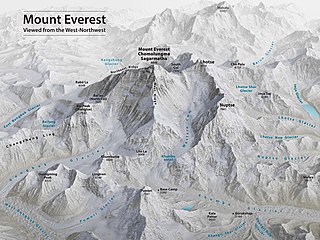
Mount Everest is the world's highest mountain, with a peak at 8,849 metres (29,031.7 ft) above sea level. It is situated in the Himalayan range of Solukhumbu district, Nepal.
Tormod Granheim is a Norwegian adventurer and motivational speaker involved in expeditions and extreme skiing. On May 16, 2006, he made the first ski descent of Mount Everest's North Face by the Norton Couloir.

Tomas Kenneth Olsson was a Swedish adventurer and ski mountaineer. He was born in Kristinehamn but grew up in Borås. He took an engineering degree at Linköping University in 2001, after which he moved to Chamonix in France to focus on skiing. He specialized in skiing down some of the world's highest and steepest mountains. He had gone from the top of Aconcagua in Argentina, Lenin Peak in Kyrgyzstan, Muztagh Ata and Kuksay Peak in China and Cho Oyu in Tibet.

The 1924 British Mount Everest expedition was—after the 1922 British Mount Everest expedition—the 2nd expedition with the goal of achieving the first ascent of Mount Everest. After two summit attempts in which Edward Norton set a world altitude record of 8,572.8 metres (28,126 ft), the mountaineers George Mallory and Andrew "Sandy" Irvine disappeared on the third attempt. Their disappearance has given rise to the long-standing speculation of whether or not the pair might – under a narrow set of assumptions – have reached the summit. Mallory's body was found in 1999 at 8,156 metres (26,760 ft), but the resulting clues did not provide any conclusive evidence as to whether the summit was reached.

The 1922 British Mount Everest expedition was the first mountaineering expedition with the express aim of making the first ascent of Mount Everest. This was also the first expedition that attempted to climb Everest using bottled oxygen. The expedition attempted to climb Everest from the northern side out of Tibet. At the time, Everest could not be attempted from the south out of Nepal as the country was closed to Western foreigners.

The Norton Couloir or Great Couloir is a steep gully high on the north face of Mount Everest in Tibet which lies east of the pyramidal peak and extends to within 150 m below the summit.

The Hornbein Couloir is a narrow and steep couloir high to the west on the north face of Mount Everest in Tibet, that extends from about 8,000 to 8,500 m elevation, 350 metres below the summit.

The Geneva Spur, named Eperon des Genevois and has also been called the Saddle Rib is a geological feature on Mount Everest—it is a large rock buttress near the summits of Everest and Lhotse. The Geneva spur is above Camp III and the Yellow Band, but before Camp IV and South Col. It is a spur near the south col. A related formation is the saddle between the peaks of Mount Everest and Lhotse.
Greg Mortimer is an Australian climber. Mortimer is notable as one of the first two Australians to successfully climb Mount Everest, on 3 October 1984. Their ascent, without supplemental oxygen, was the first via the North Face and Norton Couloir. It is one of the climbing routes that has not been repeated often.

The Lho La(Chinese: 洛拉山坳) is a col on the border between Nepal and Tibet north of the Western Cwm, near Mount Everest. It is at the lowest point of the West Ridge of the mountain at a height of 6,006 metres (19,705 ft). It is not exactly a Pass, but a part of Mt. Everest Range

The 1975 British Mount Everest Southwest Face expedition was the first to successfully climb Mount Everest by ascending one of its faces. In the post-monsoon season Chris Bonington led the expedition that used rock climbing techniques to put fixed ropes up the face from the Western Cwm to just below the South Summit. A key aspect of the success of the climb was the scaling of the cliffs of the Rock Band at about 8,200 metres (27,000 ft) by Nick Estcourt and Tut Braithwaite.

Hilaree Nelson was an American ski mountaineer. She became the first woman to summit two 8000-meter peaks in one 24-hour push on May 25, 2012. On September 30, 2018, Nelson and partner Jim Morrison made the first ski descent of the "Dream Line", the Lhotse Couloir from the summit. Lhotse is the 4th-highest mountain in the world and shares a saddle with Mount Everest.

The 1979 Yugoslav Mount Everest expedition was the first successful summit of Mount Everest (8,848m) using the entire West Ridge route in the North Face of Everest. It was the seventh expedition in the Himalayas by the Yugoslav alpinist team, and their first ascent to the highest peak of Mount Everest. The route became known as the "Yugoslavian route" after the first successful ascent. The Yugoslav state leadership declared this ascent the greatest achievement of Yugoslav sports up to that time.
